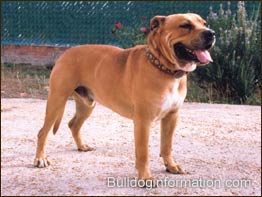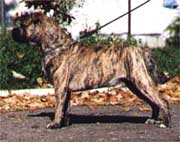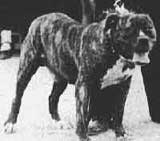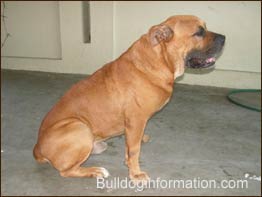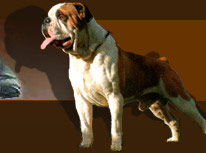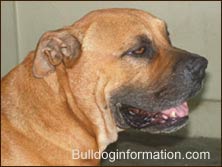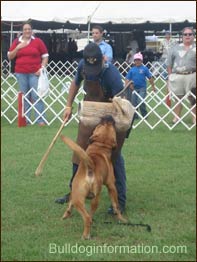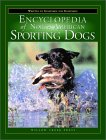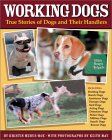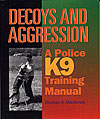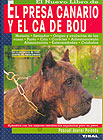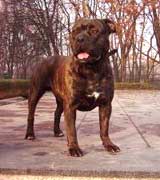Jason de Almallutx CH of Spain
Photo courtesy of Otto Brito
The Mallorquin Bulldog, or Ca de Bou, is an extremely courageous, independent dog with a combative personality.
Over the years two different types of Ca de Bou evolved: a bullier type of Ca de Bou developed by the Eastern European group of breeders and a more mastiff-like type keeping closer to the Spanish Mastiff (Mastin espanol) as seen in North America (see photo left).
Definition and Etymology
Historically the Ca de Bou originates from the island of Mallorca. The name Ca De Bou, literally means "Bull - Dog" in the native Catalan language. Perro de Presa Mallorquin is the Spanish variation of the name.
It is important to note here that Perro de presa does NOT mean "fighting dog" or "combat dog" as is sometimes thought.
Adonis the Lover
Osanna Kennel
History and Origin
Like with many other rare dog breeds the origin of the present-day Ca de Bou is subject to controversy. Some say this breed is a re-creation or a reconstruction of a Spanish breed now extinct. Others say the breed was developed using the last remaining Mallorquin Bulldog in Spain and breeding it to other breeds. Some say there were a few left and the modern stock was produced using these last remaining dogs.
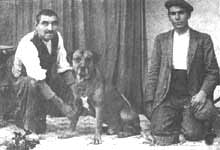
In the first millenium BC the balearics became a staging post for the Phoenicians, maritime traders from the eastern Mediterranean whose long voyages reached as far as Cornwall in southwest England. What most people fail to realise about the ancient world is the tremendous amount of trade carried on between Egypt and the other cultures around the Mediterranean. Extra-national mercantile activity was usually handled by middle-men, either logistically by Phoenicians and other mariners, or through ports-of-trade cities specifically set up by the Egyptians. Thanks to mariners and ports-of-trade, Egyptian goods and ideas spread far and wide, at least as far-west as the British Isles and eastward to the far border of India.
Among these goods were surely the dogs of Egypt, among which the Mastiff. Through the Phoenicians those dogs were probably also brought to the balearics were they interbred with local dogs evolved from neolithic dogs. From around 800 BC the Phoenecians were displaced by the Greeks who also used the island as a staging post.
In the third century BC, the expansion of the Carthagian empire across the Mediterranean and up into the Iberian Peninsula triggered two Punic Wars with Rome. On Mallorca and Menorca, the islanders took advantage of the prolonged military chaos to profit from piracy, until finally in 123 BC, the Romans restored maritime order by occupying both islands.
For the next five hundred years the Balearics were part of the Roman Empire. The armies of the Caesars also used Mastiffs as war-dogs, and they were also known to be used by the islanders for piracy. According to another theory however the Roman dogs that mixed with local dog populations where by no means huge and did not immediately affect size within local populations.
As the Roman Empire declined, westward-moving tribes of central Asia, Vandals and Alans swept across the Iberic Peninsula and the Balearics in 425 AD. The Alans brought with them a famous breed of hunting dogs which came to be known as Alans in Europe and Alanos in Iberia. The Alans were large, massive fighting dogs, used for hunting and as war dogs . See: alano history.
The term literally means "dog of prey" (compare: ave de presa = "bird of prey"), meaning a dog with a strong prey instinct and a dinstinct ability to "handle" a prey with his specific bite.
The Spanish word for "fighting dog" is perro de pelea, NOT perro de presa. The Ca de Bou or Presa Mallorquin should not to be confused with the Perro de Toro, nor with the Presa Canario which are distinct breeds.
Written by C. Marien-de Luca
for The Bulldog Information Library 2003-2010 © All rights reserved.
Ca de bou, 1907
Photo: Salvador Gómez-Toldrà
In the 17th century, Minorca and other areas came into British possession, following the treaty of Utrecht. The British brought their own fighting and guard dogs with them into the Balearics and crossed them with the native mastiffs of the Iberian Peninsula, which also occurred in the Balearic Isles. In the beginning of the 18th century, fights between dogs and bulls (bull baiting) were very popular and the Britons inhabiting the Island looked for a breed which would be held suited to such fights.
The breeding of the mallorquin dogs were further influenced by the english bulldog and their capactiy to participate in dog fights. In the Spanish Stud Book for the year 1923, the existence of this breed is already established. During the 20th century, the Mallorquin's type and morphology evolved as the breeders attempted to fix the characteristics as close as possible to those written down in the original standard. In the '80 two specimen emerge and are considered, due to their conformity, as the true-type breeding stock of the new generation of Mallorquin Bulldogs.
A typical medium-sized, powerful Molosser of somewhat elongated build. The difference between the sexes is apparent in the strong and massive head, whose circumference is definitely greater in dogs than in bitches.
In males the circumference of the head should be greater than the chest measured at the withers. The head is almost square with a strongly defined, protruding stop.
Height at the withers :
for males : from 55 to 58 cm (21.7 to 22.8) ; for females: from 52 to 55 cm (20.5 to 22 inch).
Weight :
in males the weight ranges from 35 to 38 kg (77 - 83.5 lbs), in females the weight ranges from 30 to 34 kg (66 - 75 lbs).
Temperament
The eyes are large and oval in shape and as dark as possible according to coat color. The rather small ears are typical "rose" ears and should be set high and to the sides of the skull. The tail is set low, tick at the root and tapering twoards the tip. When in action the tail forms a slight curve.
Ca de bou
(Perro de Presa Mallorquin, Mallorquin Bulldog, Dogo Mallorquin, Presa Mallorquin, Majorca Mastiff)
Mauro
Photo courtesy of Otto Brito
The skin is thick and close fitting except on the neck, where a slight dewlap may occur. The hair is short and rough to the touch. Accepted colors in order of preference are brindle, fawn and black. In brindle dogs, dark tones are preferred, in fawn, the deeper shade is preferred. White patches are permitted on the chest, front feet, and muzzle, provided the patches to not represent more than 30% of the whole coat. A black mask is also permitted. Patches of any other color are considered disqualifying faults.
Like many molosser breeds, the Ca de Bou is a very independent breed. Psychologically well-balanced, the Ca de Bou is laib-back and reserved in temperament and certainly no attention-seeker. He can lay in the sun or at your feet for hours, but does not need more than a fraction of a second to resume his task as a guardian if needed. He is naturally distrustful of strangers and his strong sense of territoriality makes him an excellent guard dog.
He is very protective and respectful of his human family and their children. He appreciates being outdoors, but can also thrive well in an apartment, provided he gets enough exercise outdoors, several times a day.

His dominant and protective temperament demands for early socialization and strict training.
Current Status
Unfortenately, few breeders of Mallorquins exist today and the total genetic pool is very restricted. In the '90 Mallorquins were exported to Russia, Poland, the USA and Japan, which explains why now part of the most important breeders can be found in these countries.
The breed is recognized by the FCI and officially called the Perra de Presa Mallorquin. However there is still much controversy concerning the exact status of this breed. Although it is listed on the FCI roster, some Spanish judges and dog breeders consider the Mallorquin Mastiff as extinct and do not recognize the present-day representative as the same dog.
.
.
.
American Bulldog Supplies
The
Bulldog Information Library 2003-2010 © All rights reserved.
Original idea, design and development by C. Marien-de Luca. No part of bulldoginformation.com may be copied, distributed, printed or reproduced on another website without the owner's written permission. Please feel free to link from your site to any of the pages on this website in a non-frame presentation only.
The Encyclopedia of North American Sporting Dogs: Written by Sportsmen for Sportsmen
by
Steve Smith (Editor)
More information
Working Dogs : True Stories of Dogs and Their Handlers
by Kristin Mehus-Roe
Explores the many ways in which dogs historically and currently serve humankind in the workplace, while encouraging sensitivity to the needs of working dog breeds kept as pets.
More information
Decoys and Aggression
A Police K9 Training Manual
by Stephen A. MacKenzie
Good for both novice and seasoned trainers
More information
Top Working Dogs: A Training Manual--Tracking, Obedience, Protection
by Dietman Schellenberg
For beginners and experts alike in the fields of tracking, obedience and man-work.
More information
Mauro
Photo courtesy of Otto Brito
El Presa Canario y el Ca de Bou
by Pascual Asensi Peinado
ed. Tikal
Dog encyclopedias and books including the Ca de bou:
The Encyclopedia of Dog Breeds
by Juliette Cunliffe
Argos Juhasz
(Junior World Winner, JChPl, ChPl)
Mea Praetoria Kennel
Mauro
Photo courtesy of Otto Brito
